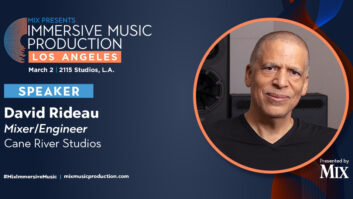
Mexico City, Mexico (March 17, 2022)—The world took notice of the post-production community in Mexico City following Sound of Metal’s 2021 Oscar win for Best Sound, for the team of Nicolas Becker, Jaime Baksht, Michelle Couttolenc, Carlos Cortés Navarrete & Phillip Bladh. The film was mixed at Baksht’s Estudio Astro LX in Mexico City.
Now, Cinematic Media, which bills itself as the only full-service post-production complex in Mexico focused exclusively on episodic television and motion pictures, has unveiled its new Dolby Atmos-certified mix stages and sound editorial rooms. Located on the lot at Estudios Gabriel Garcia Márquez (GGM) in Mexico City’s Tlalnepantla industrial area, the new sound facilities are identically equipped with components from Focusrite’s RedNet range of Dante-networked audio converters and interfaces.
Horacio Malvicino, principal of the Malvicino Design Group, handled the acoustic and technical design of the six new rooms (four in a full Dolby Atmos setup), also consulting with the equipment integrator 3BH (3BlueHouse), a professional AV specialist firm based in Mexico City. Two-time Oscar-nominated supervising sound editor and mixer Martin Hernández heads up sound services at Cinematic Media, which is led by managing director Arturo Sedano. Hernández, who regularly works with director Alejandro G. Iñarritu, was Oscar-nominated for his work on The Revenant (for which he also earned a BAFTA) and Birdman.
Cinematic Media’s six new stages, which are set up for sound design, sound editorial, pre-dubbing and mixing, each feature a pair of Focusrite RedNet HD32R 32-channel HD Dante network bridges and Red 4Pre 58-in/64-out Thunderbolt 2 and Pro Tools | HD-compatible audio interfaces (one per room). RedNet AM2 stereo audio monitoring units and RedNet X2P 2×2 Dante audio interfaces are also available on the stages.
“We tried to replicate the same rooms on all three floors of the building,” Malvicino says. “The only difference is the ceiling height, but as far as the gear, it’s all the same. Every floor has its own machine room, which is shared between the two control rooms.”
The Resonating Body in Sound of Metal
In addition to the Dante-networked RedNet equipment, each room includes four Avid Pro Tools systems, for dialog, music and effects, plus recording. Two rooms feature Avid S6 control surfaces, while the other four offer S3s. Every room also includes a JBL speaker system (consisting of C211 for the L-C-Rs, 708i for surround speakers and height speakers, JBL 4645C subs [two units per room]) – four rooms in a full Dolby Atmos 7.4.2 configuration and the remaining two in a 7.2 surround sound setup.
Focusrite was Malvicino’s number-one choice, he says. “All the rooms are connected through Dante, which is the key for this project,” he continues. “The clarity of the sound is unbelievable. The ease of installation and the cost savings are mind-boggling. I’ve been working with Focusrite for such a long time and have done numerous studios over the years with them, so for me it’s a no-brainer.”
The RedNet interfaces offer a number of advantages when it comes to their integration, he says, a factor that not everyone considers. “The units take up very little space. That’s something that people tend to overlook, especially when you do an installation where you have four computers for each room, which already take a lot of space, and you need to leave a space in between them. But Focusrite units are 1U and they don’t produce any heat, so you stack them one on top of the other and that’s it — done.”







